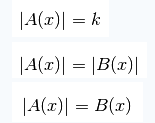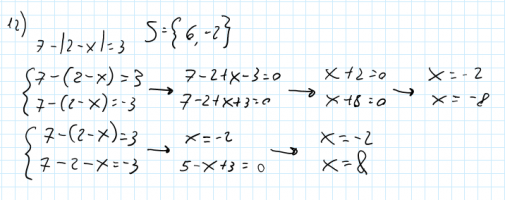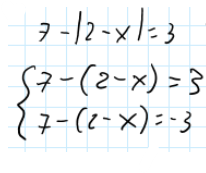Hi, I have the following equation to solve:

A very reliable website that I am learning from suggests ways to solve these kind of equalities:

But it seems to me that this equality is of the kind "p - |A(x)| = k". Sure, I could move the p to the right so it would be an equality of the first type, but my issue is that I don't know how to deal with that minus at the beginning, and the website does not provide any info about such cases. Can you please tell me how to solve this kind of equality?
Also, the website suggests ways to solve equalities of the types I mentioned above without having to put the equalities into systems with inequalities (something I have vague memories of from high school), which I appreciate very much. I'm afraid it will not be the same for this case, right? There's no workaround and I must use inequalities somehow right, because of the minus at the beginning?
These are two attempts of me trying to solve the equality with the knowledge that I have right now. I had made a third attempt but deleted it:

Thank you to anyone who will help!

A very reliable website that I am learning from suggests ways to solve these kind of equalities:

But it seems to me that this equality is of the kind "p - |A(x)| = k". Sure, I could move the p to the right so it would be an equality of the first type, but my issue is that I don't know how to deal with that minus at the beginning, and the website does not provide any info about such cases. Can you please tell me how to solve this kind of equality?
Also, the website suggests ways to solve equalities of the types I mentioned above without having to put the equalities into systems with inequalities (something I have vague memories of from high school), which I appreciate very much. I'm afraid it will not be the same for this case, right? There's no workaround and I must use inequalities somehow right, because of the minus at the beginning?
These are two attempts of me trying to solve the equality with the knowledge that I have right now. I had made a third attempt but deleted it:

Thank you to anyone who will help!

